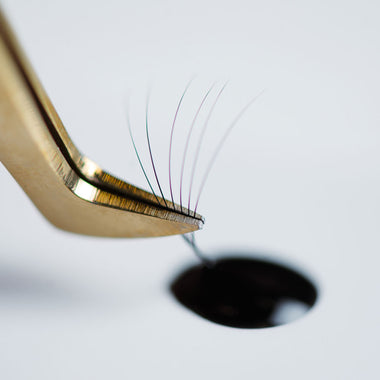Whether you’re an experienced lash artist or just starting your journey, there’s a lot to learn about new developments in the beauty industry. One of the questions you might be asking yourself is about premade vs. handmade lash fans. Which ones are better? Is there a difference? Are premade fans bad?
At Yegi Beauty, we have the answers to all your questions with an overview of both types of lash fans. Read our blog to learn more about the differences between handmade and premade fans to make the best choices for your business.
Handmade Fans

Handmade fans are created by a lash artist through a process called true volume lashing. To create handmade fans, you’ll be putting individual lashes next to each other in the shape of a fan to customize the design’s thickness, length, and density.
Once your fan is in a shape that satisfies you, dip it in adhesive so the base of the fan is coated. You want to use minimal glue to prevent adding any unnecessary weight to the piece. At this point, your fan is complete, and you can attach it to your client’s natural lashes.
While handmade fans offer you more versatility and customization vs. premade ones, it’s a lot of work and takes practice. You’ll need to experiment with individual lash pieces to create the perfect fan for each client and practice dipping your fans in adhesive to ensure they’re comfortable, lightweight, and long-lasting.
If you’re new to handmade fans and want more time to practice, premade fans may provide a good alternative for you. Are premade fans as good as handmade ones? Let’s find out.
Premade Fans

Instead of creating your own fans, you can save a ton of time and effort by exploring premade fans. Premade options, like Pro-Made lash fans, make lashing faster and easier because the individual lash pieces are already glued to each other at the base.
You’ll find Pro-Made lash fans from two to eight lashes in a single unit, with a variety of volumes that range from 3D to 12D. Premade lash fan clusters are applied with a touch more adhesive to create an invisible, seamless look along your client’s eye line.
Types of Premade Fans
Now that we’ve covered the difference between premade vs. handmade fans, let’s discuss the types of premade products. In general, there are two types of premade fans. They come either heat-bonded or glue-bonded. Let’s look at the differences between the two.
Glue-Bonded Fans
Just like handmade fans, glue-bonded premade fans are made with adhesive to bundle the individual lashes that make up the cluster. One downside of glue-bonded fans is their weight. Glue-bonded fans weigh more than heat-bonded options.
You’ll also need extra adhesive to attach the fan to a client’s natural lashes, so there may be a small clump at the base that interrupts the seamlessness of the application. However, glue-bonded handmade fans are usually sleeker and lighter because it takes lash techs years of practice to ensure even, ultra-light adhesive application.
If you’re considering glue-bonded premade fans, we recommend Pro-Made lash fans. They are handmade by experts that guarantee an even, lightweight application of adhesive for a flawless connection to a client’s natural lashes.
Heat-Bonded Fans
Heat-bonded lash fans are different from glue-bonded pieces because they use heat to seal the clusters together. These fans are typically a bit more lightweight and easier to apply to the client’s natural lashes. You’ll still need your regular adhesive to apply them. So clumping at the eye line could still happen.
Premade Fan Styles

In addition to the two manufacturing types, there are also a few different styles of premade fans. So even though you can’t customize the fans in the same way as handmade ones, you have a massive variety of looks to choose from.
- Pre-Made Fans (Long Root): Offer a dense, dramatic look
- Russian Volume (Short Root): Create a light, natural look
- Pro-Made Fans: Handmade for natural volume and fullness
- Pro-Made Spike Fans: Has a longer, thicker center spike
Pros and Cons of Premade vs. Handmade Fans
There are pros and cons to each type of fan option we’ve talked about, including damage to natural lashes, ease of application, appointment time, and more. Here’s a quick breakdown to help you weigh the benefits of each fan type.

The most significant benefits of handmade lashes are their initial cost and the customization opportunities that allow you to perfectly match each client’s lash texture, length, and thickness.
Premade vs. Handmade Fans Retention

Many lash artists think premade fans don’t last as long as their handmade counterparts. But this is not true. While older premades were bulky and over-glued, modern ones like Pro-Made lash fans are thin and sharp to ensure you get the best retention for your clients. If applied correctly, high-quality premade fans can last as long as handmade ones.
Eyelash extension longevity depends on many factors. To maximize your extension’s retention, follow these tips:
- Use fresh adhesives. Discard glue that was opened for more than four weeks. During lashing, dispense a new drop of glue every 30 seconds.
- Isolate lashes before you dip the extensions into the adhesive. Eyelash glue dries very quickly. If you dip before isolating, the glue will cure during isolation and not bond properly to natural lashes.
- Check the humidity and temperature of your room to ensure it is in the required range. Use a humidifier, dehumidifier, air conditioner, or heater to create the ideal lashing environment.
So Are Premade Fans All That Bad?
There are a few pros and cons to premade vs. handmade fans, but premade fans aren’t all that bad. The key to good premade fans is finding high-quality options that offer even, lightweight adhesive application. At Yegi Beauty, we recommend the Pro-Made brand for its consistency, variety, and longevity. Explore our collections today to find the right fans for your business!

